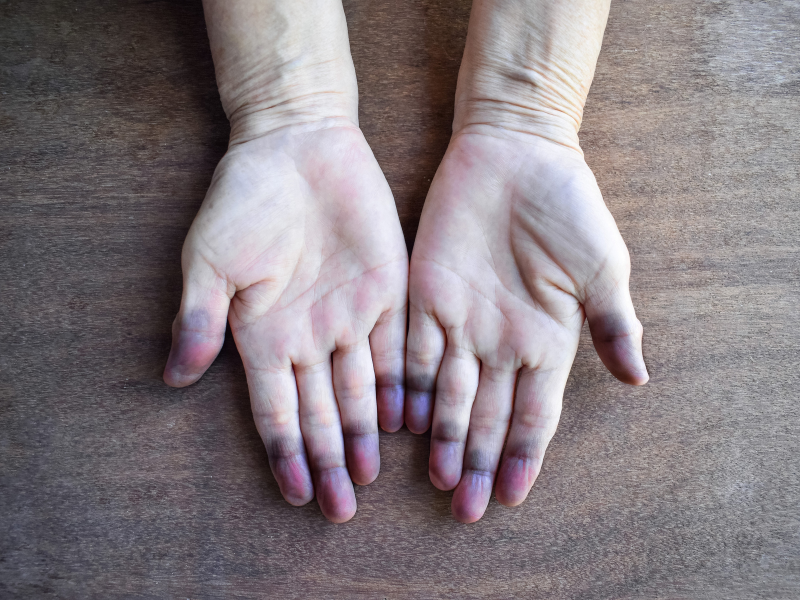Cyanosis

Cyanosis refers to bluish-purple skin, nail beds, and lips. It is especially noticeable when the skin is thin, such as the mouth, lips, earlobes, and fingernails. It occurs when the red blood cells lack sufficient oxygen. It may indicate an issue with the lungs or the heart.
Types of Cyanosis
There are three types of cyanosis:
1. Central cyanosis affects the entire body. It happens when the red blood cells leaving the heart do not receive enough oxygen. Causes include underlying conditions such as lung disease and congenital heart failure which restrict blood flow and oxygen levels. Immediate medical intervention is required in such circumstances.
2. Peripheral cyanosis affects only the extremities, such as the hands, feet, and legs. It is usually caused by exposure to cold temperatures or poor circulation. It isn’t life-threatening
3. Circumoral cyanosis affects only the mouth and lips. It is often caused by narrowed blood vessels in response to cold. Blue lips in an infant, on the other hand, may indicate a clogged airway and necessitate immediate medical intervention. In dark-skinned people, recognizing cyanosis might be difficult, making circumoral cyanosis the most noticeable symptom.
Cyanosis Causes
Common causes of cyanosis in infants may be:
· Congenital Heart Defects
· Infections like sepsis or meningitis
· Respiratory Distress
· Anemia
· Cold exposure
Common causes in adults include:
· Cardiovascular problems such as congestive heart failure or a heart attack.
· Respiratory problems such as emphysema, pneumonia, asthma, COPD, or even a blood clot in an artery of the lung.
· Exposure to substances like gold and silver salt
· Airway problems such as swelling, choking, or inflammation of the airway.
· Blood disorders like sickle cell anemia.
· Other causes like seizures, drug overdose, and medications used to treat high blood pressure.
Cyanosis Symptoms
The primary symptom of cyanosis is a bluish or purplish discoloration of the lips, skin, nail beds, or mucous membranes. Other associated symptoms may include:
- Rapid or shallow breathing (tachypnea)
- Shortness of breath (dyspnea)
- Chest pain or discomfort
- Cold or clammy skin
- Confusion or altered mental status
- Dizziness or lightheadedness
- Weakness or fatigue
Conditions That Can Lead to Cyanosis
Various medical conditions and factors can contribute to the development of cyanosis, including:
- Respiratory diseases like asthma, pneumonia, COPD
- Circulatory problems like peripheral artery disease
- Cardiovascular disorders like heart failure, congenital heart defects
- Exposure to cold
- Anemia
- Exposure to high altitude or hypoxia
- Medications and toxins
Cyanosis Treatment and Prevention
Treatment depends on the underlying cause.
· Oxygen therapy is often used to increase the amount of oxygen in the blood and alleviate symptoms.
· Treatment of specific health conditions
· Medications for the correction of metabolic abnormalities.
· Other treatments may include:
o Medications
o Surgery
o lifestyle changes
Preventing cyanosis involves addressing any underlying conditions that may be causing it. This may include:
· quitting smoking
· avoiding exposure to cold temperatures
· treating respiratory or cardiac conditions
· dressing warmly in cold weather
· practicing deep breathing exercises
· avoiding caffeine and nicotine
Cyanosis shows low oxygen levels in the blood, suggesting respiratory, cardiovascular, or circulatory issues. It’s crucial to promptly address this problem to prevent complications.
To tell if someone has cyanosis, look for a bluish or purplish tint in the skin, lips, and nails. This discoloration may be more noticeable in areas with thin skin such as the lips, fingertips, and earlobes.



